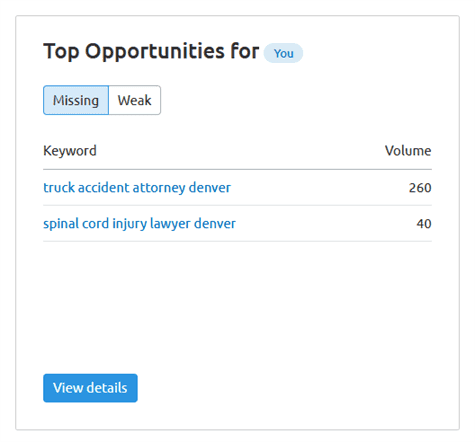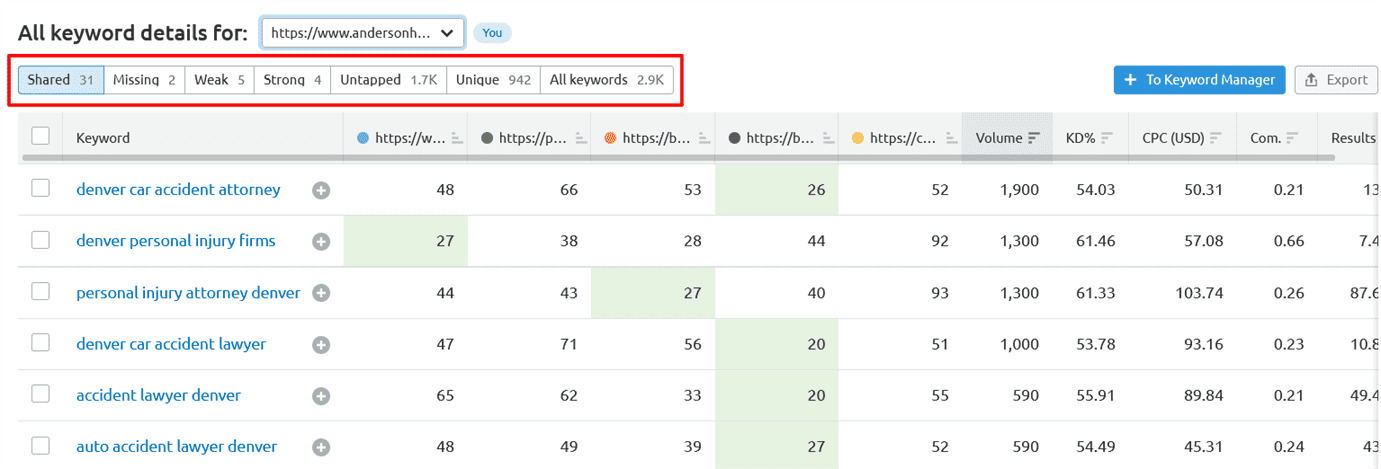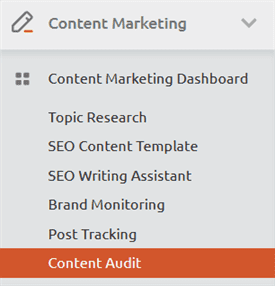When researching competitors, it’s important to make sure that your analysis tells you three things:
- what a competitor is doing;
- how they are doing it; and
- the factors they are most excelling at in their SEO strategy.
Using this information, you can create scalable strategies that will help you surpass your competitors and get higher rankings. Fortunately for SEMrush users, the platform’s suite of competitor analysis tools can help you do just that in only a few steps:
- Uncover Traffic Data
- Investigate the Market
- Identify Keyword and Content Gaps
Uncover Traffic Data
Your first order of business is to find out what your competitor’s initial stats are.
Start by analyzing the bigger picture of your competitors. This can be accomplished with the Traffic Analytics tool, located under the competitive research section of the drop-down SEO menu:
This tool can help you compare up to five competitors at once, and put yourself in a position to implement strategies that will help you overtake their positions in the search engine results pages (SERPs).
For example, let’s look at the keyword phrase denver personal injury lawyers and analyze five competitors for that space:
To do so, we’ll enter the first URL in the box of the Traffic Analytics tool’s main page and click search:
On the resulting page, we’ll individually enter the other four URLs into the box labeled competitor and click compare:
After doing this, you’ll get an overview comparing a variety of data points for each of the URLs you entered:
Specifically, you’ll see information about each URL’s:
- total number of visits;
- number of unique visitors;
- average number of pages viewed per visit;
- average visit duration; and
- average bounce rate.
So what does this information tell you about your competitors?
First of all, the main overview can help you discover at a glance which competitors are (or are not) performing in the SERPs. Then, you can move forward with examining the specific metrics mentioned above:
Keep scrolling and you’ll find a box titled Traffic Sources. This section will tell you how much of each URL’s traffic is coming from various categories—direct, referral, search, social media and paid:
Then, the Traffic Journey graph displays traffic coming from different sources over time to each of the specified URLs:
This next section, Traffic by Country, will allow you to see the traffic segmented by domain and country:
Finally, the Company Info section will display any available data about the domain owner’s company. In the cases of our five examples, no such data could be immediately found:
In such a scenario, you can manually find out more information about a domain owner by entering the URL into a database like Who.is.
Want to see even more detailed data? At the top of the overview page, you’ll find find six additional tabs labeled Audience Insights, Traffic Journey, Top Pages, Geo Distribution, Subdomains and Bulk Analysis:
Click any of the first five categories and you’ll be presented with a wealth of in-depth metrics. Or, if you’d like to analyze more than five domains at once, click on <i>Bulk Analysis</i> to enter as many as 200.
Investigate the Market
If you want to get a better idea of the market you’re competing in, you’d do well to take a look at SEMrush’s Market Explorer tool.
It can be found under the CI Add-On section of the drop-down Competitive Research menu:
To start, enter the URL of your choice into the field on Market Explorer’s main page. Select the organic competitor option and click research a market:
On the resulting page, you’ll immediately see a page titled Market Overview with a growth quadrant chart at the top. This serves to help you visualize the current competitive landscape in terms of both traffic volume and traffic growth:
Scroll down and you’ll find a section titled Domain vs Market Dynamics. Here, you can see metrics such as total, direct and referral traffic, total traffic trends, growth by sources, traffic generation strategy and basic audience demographics:
These metrics can not only help you understand how much traffic your competitors are getting and where it’s coming from, but can also assist in identifying your ideal audience and tailoring your content strategy accordingly.
Identify Keyword and Content Gaps
When performing a keyword gap analysis, you need to look at competitors’ domains along with the keywords they are ranking for.
Then, you identify gaps in the competitors’ keyword strategy, which act as windows of opportunity for you to fill with your own keyword targeting.
By finding those gaps, you’ll be able to formulate a clear strategy to go after your competitors at scale.
You can find them with the help of SEMrush’s Keyword Gap tool, located under the competitive research section of the SEO drop-down menu:
Just as with the Traffic Analytics tool, you’ll be able to compare five different domains at one time. To start, enter the five URLs of your choice, select the organic keywords option and click compare:
On the subsequent page, you’ll be presented with a box titled Top Opportunities for [URL 1]. Here, SEMrush will automatically identify missing and weak keywords you may be able to benefit from targeting:
Also at the top of the page will be a box titled <i>keyword overlap</i>. This section contains a Venn diagram showing which keywords your chosen URLs share with each other:
Venture a bit further down the page and you’ll see the meat and potatoes of SEMrush’s Keyword Gap tool, a section titled all keyword details for [URL]. Here, use the drop-down menu at the top of the section to choose the URL you want to see information about:
Then, use the upper buttons to view either shared, missing, weak, strong, untapped, unique or all keywords:
No matter which option you choose, you’ll be able to view data about each keyword’s volume, difficulty percentage, cost-per-click, competitive density and number of results:
Once you’ve completed your keyword gap analysis and established a thorough understanding of the keywords missing from your (and your competitors’) strategies, you can move forward with completing a content gap analysis.
In short, a content gap is the difference between your content and someone else’s content, and how your content helps fill in gaps in knowledge based on that.
You can benefit from performing a content gap analysis because it will allow you to lay foundations for current content performance, along with improvements that you want to make to overtake the competition. Then, you can create topic ideas targeting the entities you want to go after in the SERPs.
As part of your analysis, you’ll need to answer the following questions:
- What is your competition ranking for (i.e. keywords) that you aren’t ranking for?
- Which keywords you are ranking for from pages two–ten that your competitors are ranking for on the first page?
Once you’ve done so, you can start creating content that will surpass theirs by targeting those keywords. Start by brainstorming topics with the help of SEMrush’s Topic Research tool—you’ll find it under the Content Marketing drop-down menu:
To use it, simply enter the keyword or key phrase of your choice and you’ll be given an assortment of potential topics:
Not feeling the card-style layout? Click one of the top buttons to switch to explorer (a bare-bones list), overview (several lists grouped by category) or mind map (diagram) view:
Don’t forget to give some attention to your site’s existing content too. Even though it’s already live, you can still leverage what you’ve learned from your content gap analysis by tweaking the material you already have.
An easy way to identify weak spots in your site’s existing content is to use SEMrush’s Content Audit tool, also located under the Content Marketing drop-down menu:
On the tool’s main page, click add new Content Audit:
Then enter the URL of the site you’re analyzing in the resulting pop-up box. Click create project and you’ll be taken to a page that allows you to select the subfolders you want to audit:
After selecting the subfolders you want SEMrush to audit, click start audit and you’ll see a list of all the content that needs improvement. It will be broken down into handy categories like rewrite or remove, need to update and quick review:
Don’t forget that lower performing pages don’t always need a complete content overhaul: Even something as simple as a new, catchy meta description or page title can improve rankings.
This is why it’s important to not go after the forest while ignoring the trees—low-hanging fruit can produce significant results, and often more quickly.
By implementing a content gap analysis into your SEO workflow in this manner, it is possible to achieve a great competitive advantage.
Don’t Settle for 15 Minutes of Fame
The renowned basketball coach Pat Summitt once observed that “it’s harder to stay on top than it is to make the climb.” This is just as true in SEO as it is in sports: No matter how well you’re doing today, if you don’t keep up with what your competitors are doing then you’re bound to fall behind tomorrow.
That’s precisely why competitor analysis is so crucial. With SEMrush’s tools in your arsenal, you’ll be able to gain invaluable insights into your competitors’ successes, learn from their failures and get the knowledge you need to come out on top.
Image credits
Screenshots by iloveseo.com / December 2020
SEMrush / July 2019


































